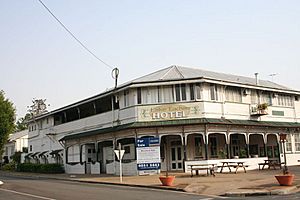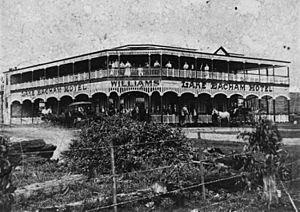Lake Eacham Hotel facts for kids
Quick facts for kids Lake Eacham Hotel |
|
|---|---|

Lake Eacham Hotel, 2009
|
|
| Location | 6-8 Kehoe Place, Yungaburra, Tablelands Region, Queensland, Australia |
| Design period | 1900 - 1914 (early 20th century) |
| Built | 1910 |
| Official name: Lake Eacham Hotel | |
| Type | state heritage (built) |
| Designated | 21 October 1992 |
| Reference no. | 600473 |
| Significant period | 1910s, 1920s (fabric) 1910-ongoing (historical use) |
| Significant components | garden - bed/s, pathway/walkway, furniture/fittings, bushhouse/fernery, post/s - lamp |
| Builders | Side Brothers |
| Lua error in Module:Location_map at line 420: attempt to index field 'wikibase' (a nil value). | |
The Lake Eacham Hotel is a historic hotel located at 6-8 Kehoe Place in Yungaburra, Queensland, Australia. It was built in 1910 by the Side Brothers. This important building is listed on the Queensland Heritage Register, which means it's officially recognized for its special history and design.
A Look Back: The Hotel's Story
The Lake Eacham Hotel was built in 1910 for the Williams family. This happened when the railway line reached Yungaburra. The hotel was made much bigger in 1926. This was just in time for the first road connecting the coast to Yungaburra. This new road helped Yungaburra become a popular place for tourists. It also became a main entry point to the beautiful Atherton Tableland.
Yungaburra's Early Days
Yungaburra was first planned in 1888 as a village called Allumbah. This plan allowed settlers to have farm blocks and homes close together. Around this time, a railway started being built from Cairns to the Tableland. It took a long time to finish. The first farms in Allumbah started in 1891, but the village plan didn't work out well.
The railway reached Mareeba in 1895 and Atherton in 1903. This made it much easier to get to the area. More people started settling around Allumbah in the early 1900s. The land where the hotel now stands was bought by George O'Donnell in 1899. It was later divided into smaller blocks in 1910.
The Railway Changes Everything
The railway commissioner bought some land for the new Yungaburra railway station. This caused the town's center to move closer to the station. Buildings were either built new or moved to be near the railway. Albert and Frederick Williams bought two blocks near the station in 1911. The Williams family continued to buy more land in the area over the next few years.
Henry S. Williams, the family's father, came to Australia in the 1860s. He worked in many jobs before settling on land at Scrubby Creek. After losing his dairy cows, he started a store and butchery. He also ran a hotel called the Carriers Arms. In 1898, he opened a store in the original Allumbah settlement. He passed away in 1905, but his family kept the business going.
In 1907, the family opened a simple inn, or "shanty," in Allumbah. It offered drinks, food, and a place to stay. Sixteen-year-old Maud Williams ran it. On March 15, 1910, the first train arrived in the settlement. The town was renamed Yungaburra to avoid confusion with another town. The railway brought quick growth, with a sawmill, shops, and houses being built.
Building the Lake Eacham Hotel
The Williams family built a two-story timber hotel near the railway. The old shanty was then used as a flourmill. Frederick Williams first held the hotel's license, then Albert Williams from 1912. However, it's believed their sister Maud was the main person running the hotel. The new hotel was named after Lake Eacham, even though the lake was about 4 miles away. This shows the hotel was built to attract tourists visiting the lake and other natural sights.
In 1914, Maud Williams married Jack Kehoe, the stationmaster. He worked at the hotel from 1916. By 1922, he was listed as the owner. After Jack's death in 1933, Maud officially became the publican. People in the area remember her as the main reason for the hotel's success.
A Boost from the New Road
On June 26, 1926, the Gillies Highway opened. This road connected Yungaburra to Gordonvale. It was the first road that cars could easily use to reach the Tablelands. This made it simple for tourists to visit the crater lakes and other beautiful spots.
Because of this new road, the Lake Eacham Hotel was greatly expanded. A large part of the wide verandah on the upper floor was enclosed. The new section included a big lounge, a reception area, a lounge bar, and more bedrooms. Yungaburra became a popular starting point for exploring the area's natural beauty. This led to a second period of growth for the town.
E.S. (Ned) Williams was one of the founders of Cairns and Tableland Motor Services Limited, known as "White Cars." These cars picked up tourists from Cairns and took them to the Tablelands. They visited places like Malanda and its Falls, the Curtain Fig, Mount Quincan, and the lakes. Tourists could rent boats at Lake Eacham from 1920, and a snack bar opened there in 1930. Lake Barrine's teahouse was built in 1927.
The White Cars company had a fuel stop in Yungaburra. They even had two mechanics there. Passengers often stayed at the Lake Eacham Hotel. This service continued for many years and the company, now called Whitecar Coaches, still exists today.
The Hotel's Role in the Community
In 1926, the Lake Eacham Hotel advertised that it was close to golf courses and public tennis courts. Movies were shown in the hall behind the hotel for many years. The hotel also hosted dances and other social events. During World War II, soldiers often stayed there and used the lounge bar.
In the 1960s, some ground floor rooms were changed into motel units. The railway line to Yungaburra closed in 1963. The old station and tracks are now gone. The hotel now looks out over a small park named after Maud Kehoe. Maud Kehoe passed away in 1971. She had been involved with the hotel for over sixty years. The hotel was sold in 1974 and changed owners several times. The current owners bought it in 1982. The hotel still welcomes tourists and is a popular attraction itself.
What the Hotel Looks Like
The Lake Eacham Hotel is a two-story building made of timber. It has an L-shape and a hipped roof covered with corrugated iron. The corner of the building where the main entrance and bar are located is cut off. The entrance for guests is in the newer part of the building and faces the main road. There is a lamppost at the street corner of the hotel.
Inside the Hotel
The original entrance hall has the public bar and games area to the left. A large dining room is to the right. This dining room can be separated from the lounge by sliding doors with colorful lead light panels. The main entrance to the lounge, which also serves as a reception area, is from the street. The glass doors have "Williams' Lake Eacham Hotel" etched on them.
The lounge is a big room with lots of beautiful silky oak and other fancy timbers. These timbers are used in the wainscotting (wood paneling on the lower part of the walls), a detailed staircase, and other wooden features. The upper walls and ceiling are covered with fibrous cement and stained timber strips. Near the entrance, there is a wooden and glass reception office and a telephone booth for guests. The room has a large fireplace and still has most of its original furniture, including tables with marquetry (decorative wood patterns) and a firescreen. At the back of the lounge is the lounge bar. It also has wood paneling and the original horseshoe-shaped bar with glass and timber cabinets above.
The kitchen has a very large, old-fashioned cast iron Metters range. This stove has ovens on all sides. It was changed to burn oil but is not currently used. The upper floor of the hotel has 38 bedrooms, manager's living areas, and sitting areas for guests.
Outside the Hotel
Behind the building, there is a barbecue area that leads to a garden. You can see parts of an old formal garden, including a round bush house, paths, and walls made of volcanic rock. There is also a single-story timber building along Cedar Street. This building is thought to have been where staff lived.
Why the Hotel is Special
The Lake Eacham Hotel was added to the Queensland Heritage Register on October 21, 1992. This means it meets certain important standards.
A Glimpse into History
The hotel was built in 1910 and made bigger in 1926 to welcome tourists. This shows how Yungaburra grew and how the early tourism industry developed in the region.
Learning from the Past
The hotel is a great example of an early resort hotel. It has large, well-designed public areas that are still in good condition. By studying the layout of the rooms and how the hotel was added to over time, we can learn about how hotels changed to meet tourist needs since 1910.
Unique Features
The hotel is special because of how well-preserved its dining and reception areas are. It still has unique details like the receptionist's office and the guest telephone booth in the lounge. The huge cast iron stove in the kitchen is also a rare find. Many of its original furniture pieces are still there.
A Beautiful Landmark
The Lake Eacham Hotel is a large building that stands out in Yungaburra. It has been a landmark since it was built and has even appeared on tourist postcards. Its design, size, and details make it a very important part of the Yungaburra town view.
Connected to Important People
The hotel has a strong connection to the Williams family, who were very important in Yungaburra's development. It is especially linked to Maud Williams Kehoe. She managed the hotel for almost its entire early history until she passed away.



